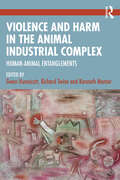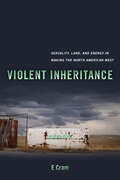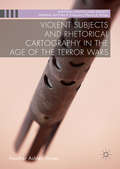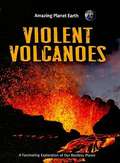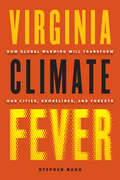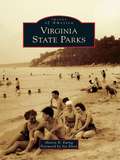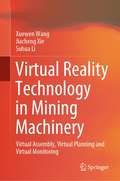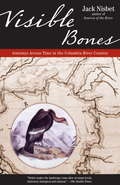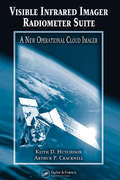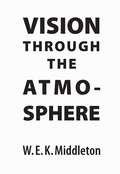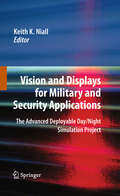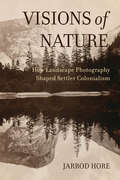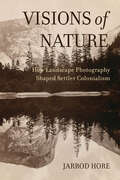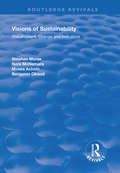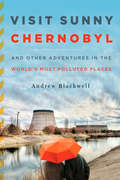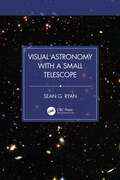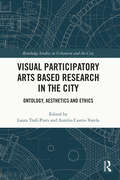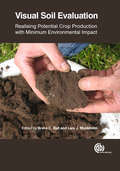- Table View
- List View
Violence and Harm in the Animal Industrial Complex: Human-Animal Entanglements
by Richard Twine Gwen Hunnicutt Kenneth MentorThis book grapples with multispecies violent exploitations embedded in corridors of power within the animal-industrial complex (A-IC). The A-IC is a useful framework for understanding how exploitative human-animal relations are central to capitalist relations and profit accumulation. ‘A-IC-related-violence’ – killing animals for economic gain – has a ripple effect which results in profound consequences for humans as well.This collection of international scholarship explores topics as varied as how A-IC-related-violence is reproduced and sustained through rapidly changing discursive strategies, ideological architecture, and particular cultural forms that elide and legitimize animal cruelty. Several chapters expose collusion between governments, corporations, and academia as central to maintaining dominance of A-IC-related-violence. Other scholars explore the trouble with making the conditions of “meat” production visible – of de-fetishizing meat commodities. The scholarship critically explores dynamic components of an apparatus that enables A-IC-related-violence and harm but is situated within the capitalist order and charts A-IC-related-violence as the key profit-generating practice in select domains of the A-IC.The book unmasks inherent cruelties in a proliferation of social forms that ultimately reflect a socioeconomic system that centralizes capitalist life characterized by endless growth, competitiveness, and profligate consumption. This is essential reading for those engaged in critical criminology, green criminology, violence studies, peace and conflict studies, critical animal studies, or animal rights-oriented scholars.
Violence in Place, Cultural and Environmental Wounding: Cultural and Environmental Wounding (Routledge Research in Culture, Space and Identity)
by Amanda KearneyHuman life is intimately woven into place. Through nations and homelands, monuments and sacred sites it becomes the anchorage point for ethnic, cultural and national identities. Yet it is also place that becomes the battlefield, war zone, mass grave, desecrated site and destroyed landscape in the midst or aftermath of cultural wounding. Much attention has been given to the impact of trauma and violence on human lives across generations, but what of the spaces in which it occurs? How does culturally prescribed violence impact upon place? And how do the non- human species with whom we coexist also suffer through episodes of conflict and violence? By identifying violence in place as a crisis of our times, and by encouraging both the witnessing and the diagnosing of harm, this book reveals the greater effects of cultural wounding. It problematises the habit of separating human life out from the ecologies in which it is held. If people and place are bound through kinship, whether through necessity and survival, or choice and abiding love, then wounding is co- terminus. The harms done to one will impact upon the other. Case studies from Australia, North and South America, Europe and the Pacific, illustrate the impact of violence in place, while supporting a campaign for methodologies that reveal the fullness of the relational bond between people and place. The book will appeal to students and practitioners alike, with interests in cultural and human geography, anthropology, environmental humanities and moral ecology.
Violent Inheritance: Sexuality, Land, and Energy in Making the North American West (Environmental Communication, Power, and Culture #3)
by E CramViolent Inheritance deepens the analysis of settler colonialism's endurance in the North American West and how infrastructures that ground sexual modernity are both reproduced and challenged by publics who have inherited them. E Cram redefines sexual modernity through extractivism, wherein sexuality functions to extract value from life including land, air, minerals, and bodies. Analyzing struggles over memory cultures through the region's land use controversies at the turn of and well into the twentieth century, Cram unpacks the consequences of western settlement and the energy regimes that fueled it. Transfusing queer eco-criticism with archival and ethnographic research, Cram reconstructs the linkages—"land lines"—between infrastructure, violence, sexuality, and energy and shows how racialized sexual knowledges cultivated settler colonial cultures of both innervation and enervation. From the residential school system to elite health seekers desiring the "electric" climates of the Rocky Mountains to the wartime incarceration of Japanese Americans, Cram demonstrates how the environment promised to some individuals access to vital energy and to others the exhaustion of populations through state violence and racial capitalism. Grappling with these land lines, Cram insists, helps interrogate regimes of value and build otherwise unrealized connections between queer studies and the environmental and energy humanities.
Violent Subjects and Rhetorical Cartography in the Age of the Terror Wars
by Heather Ashley HayesThis work examines violence in the age of the terror wars with an eye toward the technologies of governance that create, facilitate, and circulate that violence. In performing a rhetorical cartography that explores the rise of the US armed drone program as well as moments of resistive violence that occurred during the Arab Spring directed at generating a counter-hegemony by Muslim populations, the author argues that the problem of the global terror wars is best addressed by a rhetorical understanding of the ways that governments, as well as individual subjects, turn to violence as a response to, or product of, the post September 11th terror society. When political examinations of terrorism are facilitated through understandings of discourse, clearer maps emerge of how violence functions to offer mechanisms by which governing bodies, and their subjects, evaluate the success or failure of the "War on Terror. " This book will be of interest to public policymakers and informed general readers as well as students and scholars in the fields of rhetoric, political theory, critical geography, US foreign relations/policy, war and peace studies, and cultural studies.
Violent Volcanoes
by Terry JenningsDiscusses volcanoes and how they work using statistics and case studies.
Virginia Climate Fever: How Global Warming Will Transform Our Cities, Shorelines, and Forests
by Stephen NashClimate disruption is often discussed on a global scale, affording many a degree of detachment from what is happening in their own backyards. Yet the consequences of global warming are of an increasingly acute and serious nature.In Virginia Climate Fever, environmental journalist Stephen Nash brings home the threat of climate change to the state of Virginia. Weaving together a compelling mix of data and conversations with both respected scientists and Virginians most immediately at risk from global warming's effects, the author details how Virginia's climate has already begun to change. In engaging prose and layman's terms, Nash argues that alteration in the environment will affect not only the state's cities but also hundreds of square miles of urban and natural coastal areas, the 60 percent of the state that is forested, the Chesapeake Bay, and the near Atlantic, with accompanying threats such as the potential spread of infectious disease. The narrative offers striking descriptions of the vulnerabilities of the state's many beautiful natural areas, around which much of its tourism industry is built.While remaining respectful of the controversy around global warming, Nash allows the research to speak for itself. In doing so, he offers a practical approach to and urgent warning about the impending impact of climate change in Virginia.
Virginia State Parks
by Joe Elton Sharon B. EwingPres. Franklin Roosevelt's establishment of the Civilian Conservation Corps in 1933 had lasting conservation impacts across the nation. Virginia joined this effort when Will Carson of the Virginia Conservation Commission convinced Roosevelt to use the Civilian Conservation Corps to build a state park system. Virginia is distinguished as the only state in the nation to open a system of state parks on one day. On June 15, 1936, the first six state parks--Douthat, Seashore (present day First Landing), Hungry Mother, Fairy Stone, Westmoreland, and Staunton River State Parks--were opened. From these humble beginnings, the commonwealth has developed over 35 diverse, award-winning state parks. From seashore to mountains, take a journey across Virginia through a vast array of landscapes and unrivaled natural and cultural resources.
Virtual Geographies: Bodies, Space and Relations (Sussex Studies in Culture and Communication)
by Mike Crang Jon May Phil CrangThis book examines the interrelationship between telecommunications and tourism in shaping the nature of space, place and the urban at the end of the twentieth century. They discuss how these agents are instrumental in the production of homogenous world-spaces, and how htese, in turn, presuppose new kinds of political and cultural identity.Virtual Geographies explores how new communication technologies are being used to produce new geographies and new types of space. Leading contributors from a wide range of disciplines including geography, sociology, philosophy and literature:* investigate how visions of cyberspace have been constructed* offer a critical assessment of the status of virtual environments and geographies* explore how virtual environments reshape the way we think and write about the world. This book sets recent technological developments in a historical and geographical perspective to offer a clearer view of the new vistas ahead.
Virtual Reality Technology in Mining Machinery: Virtual Assembly, Virtual Planning and Virtual Monitoring
by Xuewen Wang Jiacheng Xie Suhua LiThis book focuses on the application of virtual reality (VR) technology in mining machinery. It gives a detailed introduction to the application of VR technology in virtual assembly, virtual planning, and virtual monitoring. Based on the theory of digital twin, VR technology and collaborative control technology are applied to coal mining machinery equipment, which lays a foundation for the digitalization and intellectualization of coal machinery equipment and broadens the application scope of virtual reality technology in the mechanical engineering field. Through the application of VR technology in coal machinery equipment, this book provides new methods and ideas for teaching activities, scientific research activities, and actual production with rich illustrations, related table introduction, unique research ideas, and other unique contents. This book could be a useful reference for researchers in mining machinery, simulation and modeling, computer-aided engineering (CAD and CAE) and design, visualization, mechanical engineering, and other disciplines.
Virtual Topology and Functor Geometry (Lecture Notes in Pure and Applied Mathematics)
by Fred Van OystaeyenIntrinsically noncommutative spaces today are considered from the perspective of several branches of modern physics, including quantum gravity, string theory, and statistical physics. From this point of view, it is ideal to devise a concept of space and its geometry that is fundamentally noncommutative. Providing a clear introduction to noncommutat
Virtualism, Governance And Practice
by Paige West James G. CarrierMany people investigating the operation of large-scale environmentalist organizations see signs of power, knowledge and governance in their policies and projects. This collection indicates that such an analysis appears to be justified from one perspective, but not from another. The chapters in this collection show that the critics, concerned with the power of these organizations to impose their policies in different parts of the world, appear justified when we look at environmentalist visions and at organizational policies and programs. However, they are much less justified when we look at the practical operation of such organizations and their ability to generate and carry out projects intended to reshape the world.
Virtuelle und mögliche Welten in Physik und Philosophie
by Hans J. PirnerWas sind mögliche Welten und was haben Entwicklungen der modernen Physik mit Ideen über mögliche Welten in der Philosophie zu tun? In der Beantwortung dieser Fragen entwickelt das vorliegende Werk das wissenschaftliche Weltbild im Vergleich mit möglichen Welten und gelangt so zu einem besseren Verständnis unserer einzigen wirklichen Welt. Dazu beschreibt der Autor die kreativen Ideen, die zur klassischen Physik, zur Quantenphysik und zur Erforschung des Ursprungs des Weltalls geführt haben. Er lädt den Leser ein, mit ihm über die Versuche in der modernen Physik nachzudenken, Parallelwelten und neue Universen einzuführen. Man erfährt, wie in Physik und Philosophie mögliche Welten als Instrumente verwendet werden, um unsere Erkenntnisse zu erweitern. Es wird erläutert, wie man sich mögliche Welten auch außerhalb der Physik vorzustellen hat und welchen Anforderungen diesen genügen. Unter diesem Gesichtspunkt analysiert der Autor abschließend die Zukunftsvisionen der Science-Fiction Literatur und die neuesten Erkenntnisse über künstliche, virtuelle und hybride Welten. Anhänge mit vertieftem physikalischen Hintergrund und ein ausführliches Glossar unterstützen die interessierten Lesern und Leserinnen dabei, einen Überblick über die vielfältigen Begriffe und Sachverhalte zu behalten.
Viscoelastic Interfaces Driven in Disordered Media
by François P. LandesThis book offers an in-depth study of two well-known models of "avalanche" dynamics, modified minimally by the inclusion of relaxation. Many complex systems respond to continuous inputs of energy by accumulation of stress over time, interrupted by sudden energy releases called avalanches. The first model studied is the viscoelastic interface driven over disorder, which is shown to display the fundamental features of friction. In the mean-field limit, the friction force derived semi-analytically is compatible with laboratory experiments (displaying both velocity weakening and contact aging). In two dimensions, large-scale numerical simulations are in good agreement with the basic features of real earthquakes (Gutenberg-Richter Law, aftershock migration). The second model is a non-Markovian variant of Directed Percolation, in which we observe that the universality class is only partly modified by relaxation, a promising finding with respect to our first model.
Visible Bones
by Jack NisbetHow can you know a place? Historian and naturalist Jack Nisbet--author of Sources of the River: Tracking David Thompson Across Western North America--looks to the relics of a region to connect the present moment to the distant past. In the vast Western territory defined by the Columbia River, Nisbet tracks the stories and meaning of relics such as a trilobite fossil that points to a tropical prehistoric ecology; the nearly extinct California condor, once the largest thing in the skies, described with amazement by Meriwether Lewis; the indelible stain of the smallpox pandemic that overcame the native peoples of the West; a rare and socially potent strain of indigenous wild tobacco that reveals the presence of vestigial Indian practices; and the remains of one Jaco Finlay, a mixed-blood trapper and scout who seems to have been everywhere in the region two hundred years ago. All of these relics are the visible bones that show how past is present in the Columbia River Country. Together the stories these bones tell lays out a wholly original, hybrid history that connects nature with human endeavor, geography with the passage of time--all contribute to the biography of a place. The arrow of time travels in one direction, and this is usually how history is told: beginning to end. But Jack Nisbet is up to something else: journeys across time through a place, knitting past to present and back again to assemble a portrait of the land that marked the culmination of Lewis & Clark's expedition, that saw the sad end of the Indian Wars with the flight of Chief Joseph, that has offered up fossil proof of mammoth species long extinct. In this western territory, the storied past is much in evidence.
Visible Infrared Imager Radiometer Suite: A New Operational Cloud Imager
by Keith D. Hutchison Arthur P. CracknellThe Visible Infrared Imager Radiometer Suite (VIIRS) is the next-generation multispectral imaging instrument to fly on US operational, polar-orbiting meteorological satellites. VIIRS will gather data across 22 spectral bands and be used to create products for a variety of applications including weather forecasting and climate change studies. VIIRS
Vision Through the Atmosphere (Heritage)
by W.E.K. MiddletonIn recent years, the problem of seeing through the atmosphere has been given intensive and costly consideration in several quarters, but particularly in the Untied States and Great Britain. A problem which once concerned mainly the meteorologists has become of great importance in military tactics as well as in peacetime transportation. The present volume is the only full account in English of the physical, physiological, and psychological factors which lie at the basis of the calculation of the range of vision through the atmosphere. There is an extended chapter on instruments and one on the author's own theory of the colours of distant objects. The figures are from many sources althrough many of them have been drawn specially for this book. The bibliography contains 420 entries nearly all of which are directly referred to in the text.
Vision and Displays for Military and Security Applications
by Keith K. NiallThe book discusses advances in projection technologies used for simulation in military and security applications. More specifically, the subject of this book is using high-resolution projection display technology for simulating night vision device conditions while increasing the distance that objects can be simulated under simulated daylight conditions. Topics covered include: advances in high-resolution projection, advances in image generation, advances in geographic modelling or photogrammetric technologies, night vision goggle human factors research, night vision goggle training techniques. The book will have special features including graphs and systems operational architectural diagrams specific to these domains. The main benefit the reader will gain from this book is that it will present leading edge methods for conducting human factors research for night vision device research, while also presenting leading edge technologies used design and apply visual displays for current simulations.
Visions of Nature: How Landscape Photography Shaped Settler Colonialism
by Dr. Jarrod HoreVisions of Nature revives the work of late nineteenth-century landscape photographers who shaped the environmental attitudes of settlers in the colonies of the Tasman World and in California. Despite having little association with one another, these photographers developed remarkably similar visions of nature. They rode a wave of interest in wilderness imagery and made pictures that were hung in settler drawing rooms, perused in albums, projected in theaters, and re-created on vacations. In both the American West and the Tasman World, landscape photography fed into settler belonging and produced new ways of thinking about territory and history. During this key period of settler revolution, a generation of photographers came to associate "nature" with remoteness, antiquity, and emptiness, a perspective that disguised the realities of Indigenous presence and reinforced colonial fantasies of environmental abundance. This book lifts the work of these photographers out of their provincial contexts and repositions it within a new comparative frame.
Visions of Nature: How Landscape Photography Shaped Settler Colonialism
by Dr. Jarrod HoreVisions of Nature revives the work of late nineteenth-century landscape photographers who shaped the environmental attitudes of settlers in the colonies of the Tasman World and in California. Despite having little association with one another, these photographers developed remarkably similar visions of nature. They rode a wave of interest in wilderness imagery and made pictures that were hung in settler drawing rooms, perused in albums, projected in theaters, and re-created on vacations. In both the American West and the Tasman World, landscape photography fed into settler belonging and produced new ways of thinking about territory and history. During this key period of settler revolution, a generation of photographers came to associate "nature" with remoteness, antiquity, and emptiness, a perspective that disguised the realities of Indigenous presence and reinforced colonial fantasies of environmental abundance. This book lifts the work of these photographers out of their provincial contexts and repositions it within a new comparative frame.
Visions of Sustainability: Stakeholders, Change and Indicators (Routledge Revivals)
by Stephen Morse Nora McNamara Benjamin OkwoliThis title was first published in 2000: Sustainable development has grown to compass cultural, socio-economic, political and environmental issues, and the use of Sustainability indicators (SIs) is seen by many as central to its implementation. After all, how can one ’do’ sustainable development unless one knows when it has been attained? The adoption of SIs in such a context is logical, but does present a number of practical difficulties. So far much of the published material consists of theoretical SI frameworks, with little practical experience on their use in development scenarios. In contrast, this volume is based on the results of a six year project designed to develop and evaluate the use of SLs in a Nigerian village. For the first time this takes into consideration the views and perspectives of the local population, and in doing so addresses key issues that are vital for anyone attempting to put sustainable development into practice.
Visit Sunny Chernobyl: And Other Adventures in the World's Most Polluted Places
by Andew BlackwellFor most of us, traveling means visiting the most beautiful places on Earth—Paris, the Taj Mahal, the Grand Canyon. It's rare to book a plane ticket to visit the lifeless moonscape of Canada's oil sand strip mines, or to seek out the Chinese city of Linfen, legendary as the most polluted in the world. But in Visit Sunny Chernobyl, Andrew Blackwell embraces a different kind of travel, taking a jaunt through the most gruesomely polluted places on Earth. From the hidden bars and convenience stores of a radioactive wilderness to the sacred but reeking waters of India, Visit Sunny Chernobyl fuses immersive first-person reporting with satire and analysis, making the case that it's time to start appreciating our planet as it is—not as we wish it would be. Irreverent and reflective, the book is a love letter to our biosphere's most tainted, most degraded ecosystems, and a measured consideration of what they mean for us. Equal parts travelogue, expose, environmental memoir, and faux guidebook, Blackwell careens through a rogue's gallery of environmental disaster areas in search of the worst the world has to offer—and approaches a deeper understanding of what's really happening to our planet in the process.
Visiting the Past: A Guide to Britain's Archaeology
by Gillian HovellArchaeology isn’t just for academics and television presenters – it’s for everyone. And it is all around us. Get your boots on and explore Britain’s national and local archaeology sites for yourself with this revised and updated, easy-to-read, fully illustrated guide.Follow our islands’ history in this step-by-step introduction. Discover what life was like from the earliest days of human habitation right through to the world wars. Then get out to visit the best sites and see what features each era left behind for us to find – and find out how to spot archaeology for yourself in the most surprising places.Be warned: you may never look at an empty field, a stone monument or an old building in the same way again!
Visual Astronomy with a Small Telescope
by Sean G. RyanThis is a practical guide to using a small astronomical telescope of a size that corresponds to most “first” telescopes – around 75-150 mm, i.e. 3-6 inches, in diameter.Visual Astronomy with a Small Telescope is for people who are sufficiently interested in astronomy to have purchased a small telescope or received one as a gift, but who are still developing experience of using one. They may have looked at the Moon and major planets and be wondering, “What's next?” There are many books catering for casual star-gazing and many more advanced books dealing with astrophotography and astrophysics, but this is for someone who has acquired their first telescope or soon will and wants to make the most of it.It explains how the optics of the telescope function, so the reader understands what their telescope can do and how eyepieces should be selected and used depending on the type of object being observed. It details different types of astronomical objects, their astrophysical significance, and how to observe them. It contains 43 detailed, clear charts and describes 380 objects suitable for visual observation with a small telescope and explains how to locate them without needing a computer-controlled telescope. It will help readers make the most of their telescopes to successfully observe the Universe and kick-start a life-long interest in star-gazing.• Presents essential information on optics, astronomy and astrophysics for anyone with a small telescope. • Contains 43 detailed charts, based on the constellations and showing stars down to magnitude 8.5, and identifies 380 objects suitable for visual observation with a small telescope. • Written by a Professor of Astrophysics with experience as both an amateur astronomer and a professional observational astronomer using telescopes at both small and major observatories around the world.
Visual Participatory Arts Based Research in the City: Ontology, Aesthetics and Ethics (Routledge Studies in Urbanism and the City)
by Laura Trafí-Prats Aurelio Castro-VarelaVisual Participatory Arts Based Research in the Cities maps ontological, aesthetic and ethic differences between humanist and posthumanist arts-based research, while providing insight on methodological orientations to develop arts-based research with frameworks based on process-philosophies. It is the first book on arts-based research which focuses on the city, adopting a posthumanist approach to the assembled nature of urban environments, where agency is distributed across infrastructures, technologies, spaces, things, and bodies. Chapters one to seven feature a series of studies, situated in different cities in Europe and the Americas, which outline experiences of movement, inhabitancy, interdependence, collaboration, infrastructuring and sensorial re-calibration informed by art practices in film, photography, digital projection, installation, performance and art as social practice. At the core of this book is the idea that aesthetic ecologies of cities do not depend solely on human activity, relying instead on non-logocentric modalities of collective life. The book is an indispensable tool to researchers, instructors and graduate students in education, the social sciences and the arts aiming to conceive, design and develop projects in arts-based research.
Visual Soil Evaluation
by Bruce C. Ball Rachel Guimarães Tom Batey Anne Weill Dick Godwin Lothar Mueller Mary Norton Scherbatskoy Joanna Cloy Lars J. MunkholmVisual Soil Evaluation (VSE) provides land users and environmental authorities with the tools to assess soil quality for crop performance. This book describes the assessment of the various structural conditions of soil, especially after quality degradation such as compaction, erosion or organic matter loss. Covering a broad range of land types from abandoned peats to prime arable land, this useful handbook assesses yield potential across a range of scales. It also appraises the use of VSE in determining the potential of different land types for carbon storage, greenhouse gas emissions and nutrient leaching, and for diagnosing and rectifying erosion and compaction in soils.
